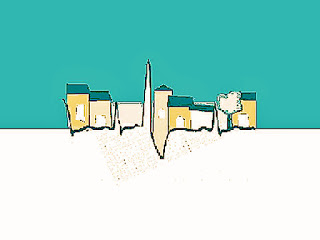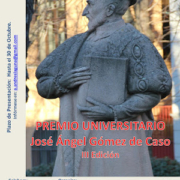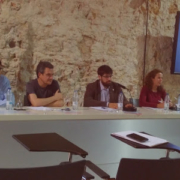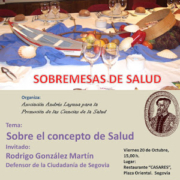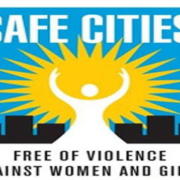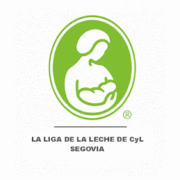CIUDADES SALUDABLES: Un movimiento ascendente.
Por Javier Tejedor.
Asociación Andrés Laguna para la Promoción de las Ciencias de la Salud.
Cuando en 1962 se publicó “La Condición Urbana”, a partir de una reunión de la Asociación Americana de Ortopsiquiatría, no sospechaba el psiquiatra Leonard Duhl, uno de los ponentes, que aquel trabajo que pretendía modificar las condiciones de vida en las ciudades para prevenir problemas psiquiátricos, sería el germen de un movimiento mucho más amplio en el ámbito de la Salud Pública, una forma de comprender la ciudad como marco de mejora de la salud, que en la década de los 70 a través del programa “Ciudades Modelo”, se intentó aplicar verticalmente por la administración americana, con escaso éxito.
Pero en 1985, con motivo del décimo aniversario del informe Lalonde, Duhl, ya profesor de salud pública en la universidad de Berkley (California), presenta su idea de “Ciudades Saludables” considerando a la ciudad como un todo y como un elemento de prevención y promoción de la Salud. El planteamiento debe ser el contrario al seguido hasta entonces, se trata de reunir intereses de distintas profesiones, distintos sectores (gobernantes, sanitarios, empresarios, movimientos comunitarios, etc) y establecer objetivos sobre la ciudad que desean, o sea, desde abajo hacia arriba. Las cuestiones en materia de salud no están solamente a cargo de los servicios sanitarios, sino que el proceso de participación ciudadana es crucial.
Pronto la Oficina Europea de la Organización Mundial de la Salud cogió este testigo, con Duhl como asesor, y se difundió al resto del mundo en forma de un movimiento que agrupaba a las ciudades bajo este modelo de gestión sanitaria.
En 2001, el profesor Duhl estuvo en la “Reunión Municipio y Salud” celebrada en Segovia, algunas de sus ideas las recoge José Ángel Gómez de Caso en el artículo “El Dr Duhl y la Ciudad Saludable”, en aquellos momentos la propuesta de los organizadores era animar a que ciudades como Segovia, con gran potencial por ofrecer calidad de vida debido a su tamaño, servicios, circunstancias ambientales y sociológicas, se sumaran a este movimiento.
Varios años después, la Asociación Andrés Laguna para la Promoción de las Ciencias de la Salud, rememora aquel evento, con una Jornada similar denominada “CIUDADES QUE TE CUIDAN”, comprobando lo que se ha avanzado, que muchas cosas han cambiado y algunas otras aún no, pero con la vista puesta en los objetivos de conseguir un mayor grado de salud en el primer nivel de convivencia –después de la familia- como es el municipio.
De la publicación resultante de aquella “Reunión Municipio y Salud”, podemos extraer algunas de las principales ideas que transmitió en profesor Duhl:
HEALTHY CITIES: THE CONCEPT
During the last 15 years there has been a major shift in thinking about health. Before most thinking and planning was linear. That is, we looked for a simple cause of an illness and then found a “cure”. Over the years, the problems in heath have become more and more complicated. There is no simple solution.
Every problem is complex, involving not just medicine and physicians, but more and more the community. We are affected by problems elsewhere in the world, which we have no control over. One example is fuel prices in the Middle East, and how they impact daily living. Nothing we can think of, does not impinge on our health.
The concept of Healthy Cities was not created by me or any other person. It evolved because the problems, now defined complexly, needed a new way to respond. We are now changing the way we ask the question. No longer, is it just how to treat a patient. Now, we impressed by the Ottawa Declaration on Health Promotion are asking how to put all the pieces together to improve the quality of life and the health of our people.
This now demand working together. It means active participation of everyone involved, to search through the complexity for new answers. That is all that Healthy Cities is about. Experts are available in specific areas. It is the people, however, who working with every group in the community, that can say what is most important to them. Thus Their vision of the future is important. So is a willingness to work with others.
We are in a time full of chaos. Only by being involved will we find new patterns of the problems and our responses.
The meeting is geared to ask questions about our apparent truths, and see if our communities can find new solutions. Slowly, we will build up competence to cope with whatever comes up and affect the quality of our lives.
Healthy Cities is a process of improving the competence of people, institutions and communities, to deal with their quality of life. To do so requires leadership and ability to understand issues in all its complexity. Systems thinking in an ecological framework are critically important. It is not the result of a single person or action, but of collaborative endeavors.
However, more than a technique, is the leader’s ability to mobilize a community to action. The techniques are those of a “social entrepreneur”, a person who can pull all the pieces and people together to deal with all the complexity and confusion. It is the ability to lead by facilitating and catalyzing, rather than giving orders. The leader must be skillful in human relation, organization and the consultation process.
Each person who participates, actually changes as they are involved in the group process. There is a turning from “self interest” to the “Common Good”. It is learning to share working in a team, conflict resolution and more. Thus, the leader is an educator-psychologist rather than a boss. The participants become active colleagues and equals in designing and implementing any change. Their perception of the issues, gradually changes. Even, the initial question gets modified, as one works within a broader framework. Values becomes central to thinking and acting.
Personal and social change are intimately connected. One must work in both areas. Indeed, unless there is also an awareness of the economic issues, the process will not work. It has been said a “True Capitalist” is one interested in the inter-relationship of economic, social and personal capital.
We learn who we are, who are our communities of interest, and what we value
Leonard Duhl in “Reunión Municipio y Salud”. Asociación Andrés Laguna para la Promoción de las Ciencias de la Salud. Segovia. 2002

